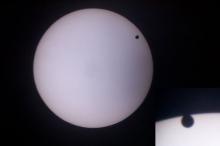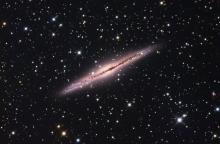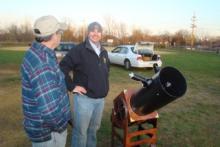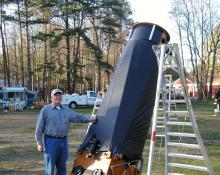Science Daily

Astronomy news. New! Earth-like extrasolar planet found; double helix nebula; supermassive black holes, astronomy articles, astronomy pictures. Updated daily.
Updated: 1 hour 5 min ago
'Cosmic lighthouses' that cleared primordial fog identified with JWST
Scientists working with data from NASA's James Webb Space Telescope (JWST) have obtained the first full spectra of some of the earliest starlight in the universe. The images provide the clearest picture yet of very low-mass, newborn galaxies, created less than a billion years after the Big Bang, and suggest the tiny galaxies are central to the cosmic origin story.
Metal scar found on cannibal star
When a star like our Sun reaches the end of its life, it can ingest the surrounding planets and asteroids that were born with it. Now, researchers have found a unique signature of this process for the first time -- a scar imprinted on the surface of a white dwarf star.
Webb finds evidence for neutron star at heart of young supernova remnant
NASA's James Webb Space Telescope has found the best evidence yet for emission from a neutron star at the site of a recently observed supernova. The supernova, known as SN 1987A, was a core-collapse supernova, meaning the compacted remains at its core formed either a neutron star or a black hole. Evidence for such a compact object has long been sought, and while indirect evidence for the presence of a neutron star has previously been found, this is the first time that the effects of high-energy emission from the probable young neutron star have been detected.
A new beginning: The search for more temperate Tatooines
Luke Skywalker's childhood might have been slightly less harsh if he'd grown up on a more temperate Tatooine -- like the ones identified in a new study. According to the study's authors, there are more climate-friendly planets in binary star systems -- in other words, those with two suns -- than previously known. And, they say, it may be a sign that, at least in some ways, the universe leans in the direction of orderly alignment rather than chaotic misalignment.
Brightest and fastest-growing: Astronomers identify record-breaking quasar
Astronomers have characterized a bright quasar, finding it to be not only the brightest of its kind, but also the most luminous object ever observed. Quasars are the bright cores of distant galaxies and they are powered by supermassive black holes. The black hole in this record-breaking quasar is growing in mass by the equivalent of one Sun per day, making it the fastest-growing black hole to date.
New realistic computer model will help robots collect Moon dust
A new computer model mimics Moon dust so well that it could lead to smoother and safer Lunar robot teleoperations.
Black hole at center of the Milky Way resembles a football
The supermassive black hole in the center of the Milky Way is spinning so quickly it is warping the spacetime surrounding it into a shape that can look like a football, according to a new study. That football shape suggests the black hole is spinning at a substantial speed, which researchers estimated to be about 60% of its potential limit.
Astronomers report oscillation of our giant, gaseous neighbor
A few years ago, astronomers uncovered one of the Milky Way's greatest secrets: an enormous, wave-shaped chain of gaseous clouds in our sun's backyard, giving birth to clusters of stars along the spiral arm of the galaxy we call home. Naming this astonishing new structure the Radcliffe Wave, the team now reports that the Radcliffe Wave not only looks like a wave, but also moves like one -- oscillating through space-time much like 'the wave' moving through a stadium full of fans.
Under pressure -- space exploration in our time
A new paradigm is taking shape in the space industry as the countries and entities accessing space continue to grow and diversify. This dynamic landscape creates both competition and potential for scientific collaboration, as well as the challenges and opportunities of progress.
Evidence of geothermal activity within icy dwarf planets
A team found evidence for hydrothermal or metamorphic activity within the icy dwarf planets Eris and Makemake, located in the Kuiper Belt. Methane detected on their surfaces has the tell-tale signs of warm or even hot geochemistry in their rocky cores, which is markedly different than the signature of methane from a comet.
Diverse ancient volcanoes on Mars discovered by planetary scientist may hold clues to pre-plate tectonic activity on Earth
A geologist has revealed intriguing insights into the volcanic activity on Mars. He proposes that Mars has significantly more diverse volcanism than previously realized, driven by an early form of crust recycling called vertical tectonics. The findings shed light on the ancient crust of Mars and its potential implications for understanding early crustal recycling on both Mars and Earth.
A star like a Matryoshka doll: New theory for gravastars
If gravitational condensate stars (or gravastars) actually existed, they would look similar to black holes to a distant observer. Two theoretical physicists have now found a new solution to Albert Einstein's theory of general relativity, according to which gravitational stars could be structured like a Russian matryoshka doll, with one gravastar located inside another.
Mysterious gap in size distribution of super-earths explained
Astronomers have uncovered evidence of how the enigmatic gap in the size distribution of exoplanets at around two Earth radii emerges. Their computer simulations demonstrate that the migration of icy, so-called sub-Neptunes into the inner regions of their planetary systems could account for this phenomenon. As they draw closer to the central star, evaporating water ice forms an atmosphere that makes the planets appear larger than in their frozen state. Simultaneously, smaller rocky planets gradually lose a portion of their original gaseous envelope, causing their measured radius to shrink over time.
Mimas' surprise: Tiny moon of Saturn holds young ocean beneath icy shell
Saturn's moon Mimas harbors a global ocean beneath its icy shell, discovered through analysis of its orbit by Cassini spacecraft data. This ocean formed just 5-15 million years ago, making Mimas a prime candidate for studying early ocean formation and potential for life. This discovery suggests life-essential conditions might exist on seemingly inactive moons, expanding our search for life beyond Earth.
A long, long time ago in a galaxy not so far away
Employing massive data sets collected through NASA's James Webb Space Telescope, astronomers are unearthing clues to conditions existing in the early universe. The team has catalogued the ages of stars in the Wolf--Lundmark--Melotte (WLM) galaxy, constructing the most detailed picture of it yet, according to the researchers. WLM, a neighbor of the Milky Way, is an active center of star formation that includes ancient stars formed 13 billion years ago.
Newly discovered carbon monoxide-runaway gap can help identify habitable exoplanets
A carbon monoxide (CO)-runaway gap identified in the atmospheres of Earth-like planets can help expand the search for habitable planets. This gap, identified through atmospheric modeling, is an indicator of a CO-rich atmosphere on Earth-like planets orbiting Sun-like stars. CO is an important compound for the formation of prebiotic organic compounds, which are building blocks for more complex molecules for the formation of life.
Which came first: Black holes or galaxies?
Black holes not only existed at the dawn of time, they birthed new stars and supercharged galaxy formation, a new analysis of James Webb Space Telescope data suggests.
Neptune-like exoplanets can be cloudy or clear
Astronomers have shown new atmospheric detail in a set of 15 exoplanets similar to Neptune. While none could support humanity, a better understanding of their behavior might help us to understand why we don't have a small Neptune, while most solar systems seem to feature a planet of this class.
Gas on the run -- ALMA spots the shadow of a molecular outflow from a quasar when the Universe was less than one billion years old
Theoretical predictions have been confirmed with the discovery of an outflow of molecular gas from a quasar when the Universe was less than a billion years old.
Bright galaxies put dark matter to the test
The earliest galaxies are thought to have formed as the gravitational pull of dark matter, which has been impossible to study directly, slowly drew in enough hydrogen and helium to ignite stars. But astrophysicists now show that after the Big Bang, hydrogen and helium gas bounced at supersonic speeds off dense, slowly moving clumps of cold dark matter. When the gas fell back in millennia later, stars formed all at once, creating small, exceptionally bright galaxies. If models of cold dark matter are correct, the James Webb Space Telescope should be able to find patches of bright galaxies in the early universe, potentially offering the first effective test for theories about dark matter. If it doesn't, scientists have to go back to the drawing board with dark matter.









